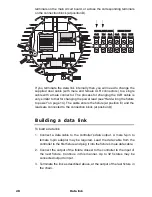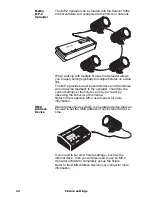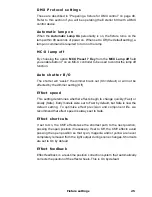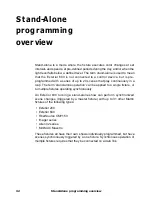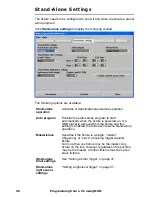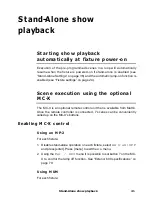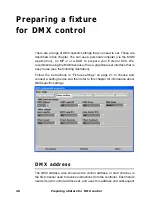
Stand-Alone programming overview
33
About scene timing
Each scene has a dynamic part -
the fade - during which effects
move to the scene’s programmed
positions, and a static part - the
wait - where effects do not change.
The duration of the fade and wait is
programmed individually for each
scene. The fade time may be 0 -
120 seconds; the wait time may be
1 second to 12 hours. The total
time it takes a scene to execute is
the sum of the fade and wait times.
When operating multiple fixtures synchronously, the wait time is determined
by the fixture that issues scene change commands. It does this when it
reaches the end of each scene wait time. Every other fixture fades and waits
at its own rate and then remains in the “wait state” until it receives a start
scene
xx
command. When programming in synchronous triggering
situations, keep in mind that in order to keep things as simple as possible
there are two rules of thumb that will make life much easier; try to ensure
that:
1. Every fixture has the same number of scenes.
2. Respective scene times are a few seconds longer on the fixture that
issues triggering commands.
The rules used in the algorithm are detailed in “Synchronous triggering
during Stand-Alone operation” on page 43.
Synchronizing scene changes for
multiple Exterior 600s
In situations where you are running multiple Exterior 600s on a data link it is
possible to synchronize scene changes.
It is important to note that each individual fixture must be programmed with
a show and that the only commands that are passed are scene change
commands. No data about the look of the scene is passed between fixtures.
Fade
Fade
Sc
en
e
1
Sc
en
e
1
S
ce
ne
3
S
ce
ne
3
Scen
e2
Scen
e2
W
ait
Wait
W
ait
Fade
Summary of Contents for Exterior 600
Page 1: ...Exterior 600 user manual m a r t i nar chi te ctu ra l ...
Page 4: ...4 ...
Page 30: ...30 General operation ...
Page 56: ...56 DMX protocol ...


